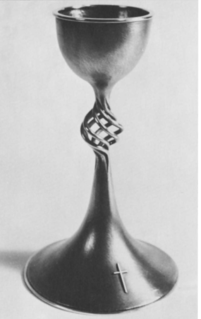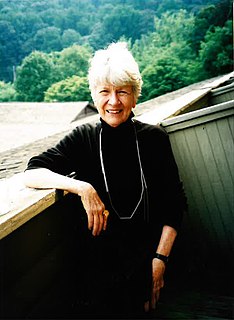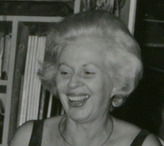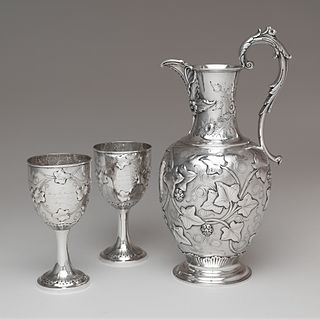Porter George Blanchard (1886–1973) was an American silversmith living and working in Pacoima, California. He is considered to be part of the Arts and Crafts Movement.

Cooper Hewitt, Smithsonian Design Museum is a design museum located in the Upper East Side's Museum Mile in Manhattan, New York City. It is one of 19 museums that fall under the wing of the Smithsonian Institution and is one of three Smithsonian facilities located in New York City, the other two being National Museum of the American Indian's George Gustav Heye Center in Bowling Green and the Archives of American Art New York Research Center in the Flatiron District. It is the only museum in the United States devoted to historical and contemporary design. Its collections and exhibitions explore approximately 240 years of design aesthetic and creativity.

John Axel Prip, also known as Jack Prip (1922–2009), was an American master metalsmith, industrial designer, and educator. He was known for setting standards of excellence in American metalsmithing. His works and designs have become famous for bringing together the formal, technical tradition of Danish design into harmony with the American desire for innovation. Several of his designs for the Reed and Barton Company are still in production today.
Frederick W. Davis operated an antiquities and folk art shop in Mexico City. Davis was an early collector and dealer in pre-Columbian and Mexican folk art and his shop was a place where Mexican Modern artists who were interested in pre-Columbian and folk art, often met.
Arline Fisch is an American artist and educator. She is known for her work as a metalsmith and jeweler, pioneering the use of textile processes from crochet, knitting, plaiting, and weaving in her work in metal. She developed groundbreaking techniques for incorporating metal wire and other materials into her jewelry.

Fred Fenster is a metalsmith and professor emeritus of the University of Wisconsin at Madison where he taught art and education. He is particularly known for his work in pewter, influencing generations of metalsmiths. Fenster was named a Fellow of the American Craft Council in 1995.

John Paul Cooper was a British architect and a leading craftsman in the Arts and Crafts Movement, specialising in metalwork and jewellery. He is particularly noted for the use of materials such as shagreen and ostrich egg in combination with precious metals and gemstones.
Hemmerle is a Munich-based jeweller founded in 1893 by brothers Joseph and Anton Hemmerle.
Jean Elysée Puiforcat was a French silversmith, sculptor and designer. Miller's Antiques Encyclopedia calls Puiforcat the "most important French Art Deco silversmith."

Margret Craver was an American artist and arts educator. She was noted for her jewelry and holloware as well as her educational and technical manuals on metalwork.

Catherine Elizabeth Cooke is an American designer whose career has lasted more than 73 years. She is principally known for her jewelry. She has been called "an icon within the tradition of modernist jewelry" and "a seminal figure in American Modernist studio jewelry". Her pieces have been shown nationally and internationally and are included in a number of museum collections, including the Museum of Modern Art (MOMA) in New York. She is regarded as an important role model for other artists and craftspeople.

Arthur George Art Smith (1917–1982) was one of the leading modernist jewelers of the mid-20th century, and one of the few Afro-Caribbean people working in the field to reach international recognition. He trained at Cooper Union, NYU, and under Winifred Mason.
Myra Mimlitsch-Gray is an American metalsmith, artist, critic, and educator living and working in Stone Ridge, New York. Mimlitsch-Gray's work has been shown nationally at such venues as the John Michael Kohler Arts Center, Museum of the City of New York, Metropolitan Museum of Art, Cooper-Hewitt Smithsonian Design Museum, and Museum of Arts and Design. Her work has shown internationally at such venues as the Middlesbrough Institute of Modern Art, Stadtisches Museum Gottingen, and the Victoria and Albert Museum, and is held in public and private collections in the U.S, Europe, and Asia.

Alma Rosalie Eikerman was an American metalsmith, silversmith, and jewelry designer who was instrumental in building the metals program at Indiana University, of which she retired Distinguished Professor Emeritus. She was a founding member of the Society of North American Goldsmiths and studied under several internationally renowned metalsmiths, such as Karl Gustav Hansen. Eikerman's work has appeared in over 200 exhibitions, including Objects: USA at the Smithsonian Institution.
Gilbert Leigh Marks was an English silversmith, who worked in the Arts and Crafts style, during a career of little over ten years.

Robert & William Wilson were American silversmiths in Philadelphia, active in partnership from roughly 1825–1846, then continuing as a mark until 1877. It was succeeded by William Wilson & Son.
Grace Hazen (1874-1940) was an American jewelry designer who founded the Hazen Crafts School at Rocky Neck, East Gloucester, MA. She specialized in hand-wrought jewelry.
Adda "Andy" Thyra Elise Louise Husted-Andersen was a Danish-born American Modernist jeweler, silversmith, metalsmith, and educator. She was a co-founder and the president of the New York Society of Craftsmen from 1941 to 1944. She was a master of working with enamel, silver and gold. She was active in New York City and Copenhagen.
Ronald Hayes Pearson was an American designer, jeweler, and metalsmith. He lived for many years in Rochester, New York and later Deer Island, Maine.

Clara Pauline Barck Welles (1869–1965) was an American silversmith who from 1910 was also successful as a suffragist. In 1900, after graduating in decorative design from the School of the Art Institute of Chicago, she encouraged five of her fellow graduates to join her in creating the Kalo Shop where they produced jewelry, textiles and leather goods. By the late 1930s, she was specializing in silverware, employing 25 silversmiths who were mostly Scandinavian immigrants. Her creations were included in an exhibit at the Museum of Modern Art.










